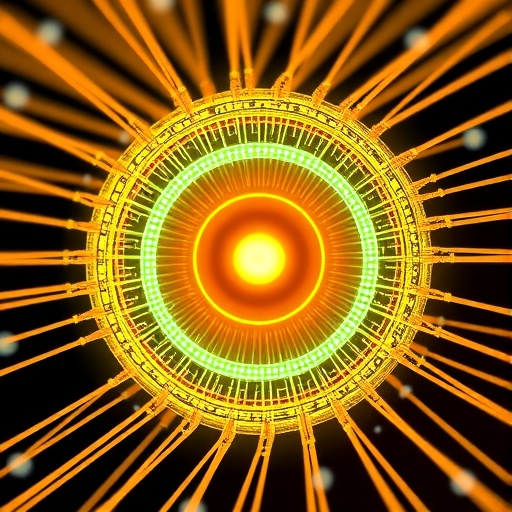In a groundbreaking advancement poised to redefine the landscape of spintronics, a research team led by Professor SHAO Dingfu at the Institute of Solid State Physics, part of the Hefei Institutes of Physical Science under the Chinese Academy of Sciences, has uncovered a novel mechanism to realize robust spin polarization by leveraging the interfaces of antiferromagnetic metals. Their pioneering findings, recently published in the esteemed journal Newton, introduce an innovative model of antiferromagnetic tunnel junctions (AFMTJs) that transcends traditional limitations, heralding a new era of faster, denser, and more energy-efficient spintronic devices.
Spintronics, an emergent technology that exploits the intrinsic spin of electrons alongside their charge, is revolutionizing the way information is processed and stored. Conventional magnetic tunnel junctions (MTJs), integral components in current data storage technology, harness ferromagnetic materials. However, these devices are plagued by inherent constraints—particularly slow switching speeds and undesirable stray magnetic fields arising from their ferromagnetic constituents. Antiferromagnetic (AFM) materials, distinguished by their zero net magnetization and absence of stray fields, offer a highly promising alternative. Their ultra-fast spin dynamics and robustness against external magnetic perturbations position them as ideal candidates for next-generation spintronic applications. Yet, this promise has been hampered by the dependency of existing AFMTJ designs on specific bulk magnetic properties, severely narrowing the spectrum of viable materials.
The research team addressed this core challenge through a paradigm shift: redirecting attention from bulk properties to interface phenomena. Traditionally underestimated, interfaces can play a decisive role in quantum transport and magnetic behaviors at the nanoscale. The group investigated how suppressing bulk contributions can unlock interface-driven spin polarization effects in A-type antiferromagnetic materials, even when such materials inherently lack spin-split bulk electronic states. This insight challenges prevailing dogma and opens a broad avenue for exploiting antiferromagnetic materials whose bulk properties were once deemed unsuitable for spintronic use.
Central to their approach was a sophisticated computational framework built on first-principles modeling. Employing this rigorous theoretical method, the researchers designed an AFMTJ constituted by a two-dimensional A-type AFM metal—specifically Fe₄GeTe₂—and a thin insulating barrier of hexagonal boron nitride (BN). Despite Fe₄GeTe₂’s bulk spectrum exhibiting spin degeneracy, the simulations revealed pronounced spin-polarized current at the heterointerface. Notably, these currents demonstrated remarkable resilience to variations in electrode thickness and stacking parity, conclusively establishing their interfacial origin rather than a bulk effect. This robustness signals practical scalability by device designers without compromising performance integrity.
Perhaps the most striking outcome was the demonstration of tunnel magnetoresistance (TMR) approaching 100%—a benchmark comparable to traditional ferromagnet-based devices. By simply toggling the magnetic moment alignments at the interface, the junction efficiently controlled electron spin transport without the drawback of stray magnetic fields. This finding illustrates the feasibility of interface-controlled AFMTJs as not only functionally superior but also materially versatile, given many antiferromagnetic metals can be engineered to grow naturally in A-type stacking configurations through optimized fabrication processes.
Experts in the field have underscored the significance of this study. Professors Jose Lado from Aalto University and Saroj P. Dash of Chalmers University of Technology, in a commentary accompanying the article, highlighted the work’s pivotal conceptual breakthrough. They emphasized that “uncompensated interfaces in antiferromagnets bring new opportunities for van der Waals heterostructures,” elucidating the broader impact on layered two-dimensional material systems and heterostructure engineering.
The implications for the post-Moore’s Law computational paradigm are profound. As traditional silicon-based electronics approach fundamental limitations due to scaling and energy dissipation challenges, spintronics offers a pathway to sustain performance growth. Interface-engineered antiferromagnetic devices, as demonstrated here, are poised to become critical enablers for this transition, combining high-speed operation, miniaturization potential, and ultra-low power consumption.
Furthermore, the reliance on interface phenomena diversifies material platforms compatible with spintronics, mitigating dependence on rare or complex ferromagnetic alloys. This factor catalyzes the exploration of newly discovered two-dimensional magnetic materials and expands integration possibilities within van der Waals heterostructures, where atomically sharp and defect-free interfaces are achievable.
The researchers’ methodology, coupling advanced first-principles theoretical tools with judicious materials selection, establishes a robust blueprint for future spintronic device engineering. This framework promotes systematic identification of candidate materials and interfaces capable of offering strong spin polarization without reliance on bulk magnetism, revolutionizing conventional design strategies.
Moreover, the study’s findings underscore the critical role of interface smoothness and stability. Achieving coherent spin transport necessitates meticulously controlled fabrication conditions, where atomic-scale precision ensures the preservation of interface-driven effects. These insights encourage the development of novel synthesis and characterization techniques tailored to this emerging class of antiferromagnetic spintronic components.
In essence, Professor SHAO Dingfu and his team have not only expanded the theoretical understanding of antiferromagnetic spintronics but have also engineered a tangible prototype with immediate practical relevance. Their work is a beacon for innovation, demonstrating that the interplay of interfacial physics and two-dimensional magnetism can surmount long-standing material challenges, offering a credible pathway toward the next generation of ultrafast, dense, and energy-efficient computational architectures.
As technological industries brace for the post-scaling era, such advances are vital. They carry the promise to unify fundamental physics breakthroughs with applied engineering, setting the stage for spintronic devices that could revolutionize memory, logic, and quantum information technologies. The new AFMTJ blueprint stands as a testament to how interface control can unlock unforeseen functionalities—ushering in a future where spin, rather than charge alone, drives the digital age.
Subject of Research: Interface-driven spin polarization in antiferromagnetic tunnel junctions for next-generation spintronics
Article Title: Interface-controlled antiferromagnetic tunnel junctions
News Publication Date: 4-Aug-2025
Web References: https://doi.org/10.1016/j.newton.2025.100142
Image Credits: SHAO Dingfu
Keywords
Physical sciences




